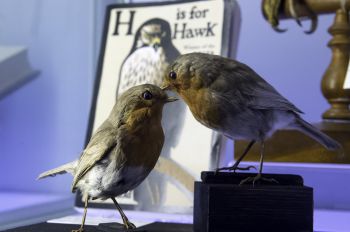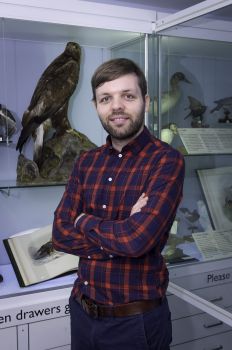Flying off the page - Exhibition celebrates birds in literature
By: Jacqui Bealing
Last updated: Tuesday, 15 May 2018

Who killed Cock Robin? Exhibits at Brighton's Booth Museum.

Dr Will Abberley at the Booth Museum.
Unreachable, untameable and largely unknowable; birds may be conspicuous in our environment, yet they remain strangely elusive.
It is this “magical sheen”, says University of Sussex lecturer in English Dr Will Abberley, that's caused them to be such an inspiration to writers.
To celebrate this human-avian connection, Will has curated an exhibition at Brighton’s Booth Museum of Natural History this summer through pairing bird-inspired British literature with taxidermy specimens.
'Stories on the Wing: British Birds in Literature', which runs until 21 September, highlights how ornithologists have turned their observations of birds into stories and how birds have sparked our imaginations through myths, folk tales and creative writing.
Texts, such as Barry Hines’ A Kestrel for a Knave and Helen Macdonald’s response to grief, H is for Hawk, are on display with their corresponding stuffed counterparts from 19th-century taxidermist Edward Booth’s collection.
The exhibition - which also features a golden eagle, an arctic tern, a kingfisher and various common garden birds - includes the museum founder Booth's own Rough Notes, in which he made detailed observations of birds in the wild.
“When Booth was creating the museum it was his ambition to capture every species of bird in the British Isles or that had migrated to the British Isles,” says Will. “He and his contemporaries were fascinated by their habitats and their behaviours.”
One of the behaviours that has clearly captivated both ornithologists and novelists is bird migration, says Will. In Thomas Hardy’s Tess of the D’Urbevilles, the narrator muses: “After this season of congealed dampness came a spell of dry frost, when strange birds from behind the North Pole began to arrive silently on the upland of Flintcomb-Ash; gaunt spectral creatures with tragical eyes - eyes which had witnessed scenes of cataclysmal horror in inaccessible polar regions of a magnitude such as no human being had ever conceived, in curdling temperatures that no man could endure …”
The independence and freedom of birds is another common theme in literature. “Birds have been domesticated, but they remain resolutely wild,” says Will. “They are mysterious creatures that we can see, but can never quite touch. They have this magical sheen.”
In Hines’ A Kestrel for a Knave, the young Billy Casper explains why he has taken to falconry to escape his life in a bleak Yorkshire mining town. “I could I could shout at 'em; it's not a pet, Sir, hawks are not pets. Or when folks stop me and say, ‘Is it tame?’ Is it heck tame, it's trained that's all. It's wild, an' it's not bothered about anybody, not even about me right. And that's why it's great.”
One of Daphne Du Maurier’s most chilling short stories, The Birds (memorably adapted by Alfred Hitchcock for the big screen), in which seagulls become merciless killers, contains the terrifying passage: “Nat listened to the tearing sound of splintering wood and wondered how many million years of memory were stored in those little brains, behind stabling beaks, the piercing eyes, now giving them this instinct to destroy mankind with all the deft precision of machines.”
Through folklore, rhymes and fairytales, birds have taken on all manner of symbolic meanings: from the cuckoo being a metaphor for a con artist, to magpies being associated with “sorrow”, “joy”, “girl” or “boy” depending on their numbers.
The poem Who killed Cock Robin?, which is believed to have originated in the 12th century or earlier and describes the bird’s death and funeral, is frequently used in literature to represent murder.
Even the eating of birds is steeped in mystical beliefs, says Will. During medieval times in some countries only the noble and brave were deemed worthy enough to dine on birds, which were regarded as higher beings because of their ability to fly.
And while birdsong has long been seen as among the big signatures of place and locality, this has been enhanced in recent years because ornithologists have found that birds, like humans, have different regional accents.
The exhibition has been funded through a grant from the Arts and Humanities Research Council (AHRC). Will, in collaboration with researchers at the universities of Leeds and St Andrews, is also writing a book about the history of nature writing in Britain, from the works of 18th-century naturalist Gilbert White through to modern fiction and non-fiction.
“A lot of researchers have looked at the history of nature writing in America and the way that these various landscapes in America became literary symbols and icons and keep being used,” says Will. “But not so much in Britain. We are trying to shine a light on non-fiction but we are interested in all kinds of literature.”
A series of talks accompanies the exhibition. On Thursday 15 June (7.30-9pm), Will is talking about 'Birds in the Victorian Imagination'. He will be joined by Professor Nicholas Royle, who will be reading from his new novel, An English Guide to Birdwatching.
On Thursday 13 July (7.30-9pm) Mark Cocker, author of Crow Country and Birds Britannica, will talk about 'Messengers and Metaphors: Birds in Art and Literature'.
And on Thursday 10 August (7.30-9pm), David Higgins, Associate Professor in English Literature at the University of Leeds, is presenting 'Romantic Writers and the Mystery of Birds’.

